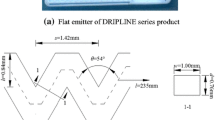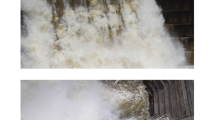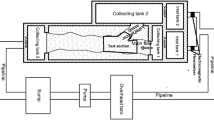Abstract
The principle theme of this study is to introduce a novel countermeasure to reduce the energy of the overflowing floodwater by utilization of a water cushion. For this purpose, laboratory experiments including “LW” cases (levee with water cushion) and “OL” cases (only levee) were conducted to elucidate the role of a water cushion in the flow structure variation after a levee is overflowed and to reduce energy. A moat (a deep and wide trench) with varying non-dimensional length (Lm* = Lm/hL; Lm is the length of the moat where hL is the levee height) and depth (Dm* = Dm/hL; Dm is the moat depth) acting as a water cushion was provided at the toe of a levee with varied landward slopes (SL). The energy reductions in the LW and OL systems were found to be very close to each other at lower overflow water depths, while it was 25% greater in the LW system than in the OL system at higher overflow water depths. Changes in the landward slope (SL) of the levee, non-dimensional length (Lm*), and depth (Dm*) of moat significantly changed the flow structure and created six different flow structures. However, 1–6%, 1–3%, and 1–5% differences in energy reduction rate were observed by varying SL, Lm*, and Dm*, respectively, in LW cases. All flow structures contributed greatly to energy reduction, but the energy reduction rate was maximum in flow structure named as T-2. Flow structures named as T-2 and T-6 are preferable due to increased water depth inside the moat and presence of submerged hydraulic jump which can be achieved during landward slopes SL = 1:1, 1:2 and by decreasing Lm* Dm*, of moat during Landward slope SL = 1:3.
Article Highlights
-
The water cushion function of moat was utilized at toe of overflowing levee.
-
The effect of different non-dimensional overflow water depths, non-dimensional length, depth of moat and varying landward slope of levee on flow structure was investigated.
-
Different flow structure was classified based on non-dimensional length and depth of moat.
-
Relation between flow structure and energy reduction rate was investigated.












Similar content being viewed by others
References
Tobita D, Kakinuma T, Yokoyama H, Takeda A (2014) Quantification of leevee breach volume based on levee breach at the Chiyoda experimental flume. J JSCE 2(4):136–143
Dewals B, Rifai I, Abderrazek KE, Greco M, Cristo CD, Iervolino M, Leopardi A, Vacca A (2018) Numerical simulation of lateral dike breaching due to overflow. River Flow 03025:1–8
Luo P, He B, Takara K, Xiong YE, Nover D, Duan W, Fukushi K (2015) Historical assessment of Chinese and Japanese flood management policies and implications for managing future floods. Environ Sci Policy 48:265–277
Tappin DR, Evans HM, Jordan CJ, Richmond B, Sugawara D, Kazuhisa G (2012) Coastal changes in the Sendai area from the impact of the 2011 Tōhoku-oki tsunami: interpretations of time series satellite images, helicopter-borne video footage and field observations. Sediment Geol 282:151–174
Tanaka N, Yagisawa J, Yasuda S (2013) Breaking pattern and critical breaking condition of Japanese pine trees on coastal sand dunes in huge tsunami caused by Great East Japan earthquake. Nat Hazards 65(1):423–442
Muhammad RAH, Tanaka N (2019) Energy reduction of a tsunami current through a hybrid defense system comprising a sea embankment followed by a coastal forest. Geosciences 9(6):1–27
Igarashi Y, Tanaka N, Zaha T (2018) Changes in flow structures and energy reduction through compound tsunami mitigation system with embankment and lined piles. Ocean Eng 164:722–732
Tanaka N, Yasuda S, Iimura K, Yagisawa J (2014) Combined effects of coastal forest and sea embankment on reducing the washout region of houses in the Great East Japan tsunami. J Hydro-Environ Res 8(3):270–280
Tokida KI, Tanimoto R (2014) Lessons for countermeasures using earth structures against tsunami obtained in the 2011 off the pacific coast of Tohoku earthquake. Soils Found 54(4):523–543
Igarashi Y, Tanaka N (2018) Effectiveness of a compound defense system of sea embankment and coastal forest against a tsunami. Ocean Eng 151:246–256
Usman F, Murakami K, Kurniawan EB (2014) Study on reducing tsunami inundation energy by the modification of topography based on local wisdom. Procedia Environ Sci 20:642–650
Rahman MM, Schaab C, Nakaza E (2017) Experimental and numerical modeling of tsunami mitigation by canals. J Waterw Port Coast Ocean Eng 143(1):1–11
Niimi T, Kawasaki K, Mabuchi Y, Nagayama K, Tsuji T, Oie T, Matsuda K (2013) Numerical examination on tsunami mitigation effect of Teizan canal. J JSCE Coast Eng 69(2):211–215
Tsujimoto G, Mineura R, Yamada F, Kakinoki T, Uno K (2014) Scouring mechanism behind seawall from tsunami overflow and optimum conditions to reduce tsunami energy with an artificail trench. In: Proceedings of the coastal engineering conference, pp 1–7
Mineura R, Tsujimoto G, Yamada F (2013) A study on scouring by overflow from seawall and application of an artificial trench. J JSCE Ser B2 Coast Eng 69:791–795
Tanaka N, Igarashi Y (2016) Multiple defense for tsunami inundation by two embankment system and prevention of oscillation by trees on embankment. In: Proceedings of the 20th congress of IAHR APD congress. Colombo, Sri Lanka, pp 28–31
Zaha T, Tanaka N, Kimiwada Y (2019) Flume experiments on optimal arrangement of hybrid defense system comprising an embankment, moat, and emergent vegetation to mitigate inundating tsunami current. Ocean Eng 173(11):45–57
Correia AS (2017) Tsunami mitigation in Japan after the 2011 Tōhoku tsunami. Int J Disaster Risk Reduct 22:397–411
Tanaka N (2009) Vegetation bio shields for tsunami mitigation: review of effectiveness, limitations, construction, and sustainable management. Landsc Ecol Eng 5:71–79
Matsuba S, Mikami T, Jayaratne R, Shibayama T, Esteban M (2014) Analysis of tsunami behavior and the effect of coastal forest in reducing tsunami force around coastal dikes. In: Proceedings of the coastal engineering conference
Pasha GA, Tanaka N (2017) Undular hydraulic jump formation and energy loss in a flow through emergent vegetation of varying thickness and density. Ocean Eng 141:308–325
Tanaka N, Jinadasa KBS, N, Mowjood M I M, Fasly M S M, (2011) Coastal vegetation planting projects for tsunami disaster mitigation: effectiveness evaluation of new establishments. Landsc Ecol Eng 7(1):127–135
Mitobe Y, Adityawan MB, Tanaka H, Kawahara T, Kurosawa T, Otushi K (2014) Experiments on local scour behind coastal dikes induced by tsunami overflow. Coast Eng Proc
Takegawa N, Sawada Y, Kawabata T (2019) Geogrid-based countermeasures against scour behind coastal dikes under tsunami overflow. Mar Georesour Geotechnol 38(1):64–72
Johnson EB, Testik FY, Ravichandran N, Schooler J (2013) Levee scour from overtopping storm waves and scour counter measures. Ocean Eng 72:72–82
Rahman MA, Tanaka N, Rehman N (2021) Experimental study on reduction of scouring and tsunami energy through a defense system consisting a seaward embankment followed by vertically double layered vegetation. Ocean Eng 234:108816
Rao BR (2005) Buckingham canal saved people in Andhra Pradesh (India) from the tsunami of 26 Dec 2004. Curr Sci 89(1):12–13
Tanaka N, Sato M (2015) Scoured depth and length of pools and ditches generated by overflow flow from embankments during the 2011 Great East Japan tsunami. Ocean Eng 109:72–82
Kimiwada Y, Tanaka N, Zaha T (2020) Differences in effectiveness of a hybrid tsunami defense system comprising an embankment, moat, and forest in submerged, emergent, or combined conditions. Ocean Eng 208:107457
Li LX, Sheng LH, Da L, Sheng-yin J (2015) Experimental investigation of the optimization of stilling basin with shallow-water cushion used for low Froude number energy dissipation. J Hydrodyn 27(4):522–529
Li Q, Li L, Liao H (2018) Study on the best depth of stilling basin with shallow-water cushion. Water (Switzerland) 10(12):1–16
Tokida K, Tanimoto R (2012) Resistance of earth bank against tsunami and structure of dug pool formed by tsunami in the 2011 off the pacific coast of Tohoku earthquake (in Japanese with english abstract). Japan Sco of Civi Eng 68(4):1091–1112
Larsen BE, Arboll LK, Kristoffersen SF, Carstensen S, Fuhrman DR (2018) Experimental study of tsunami-induced scour around a monopile foundation. Coast Eng 138:9–21
Rashedunnabi AHM, Tanaka N (2019) Energy reduction of a tsunami current through a hybrid defense system comprising a sea embankment followed by a coastal forest. Geosciences 9:247
Ahmed A, Ghumman AR (2019) Experimental investigation of flood energy dissipation by single and hybrid defense system. Water 11:1971
Costa DR, Tanaka N (2020) Role of hybrid structures on the control of tsunami induced large driftwood. Coast Eng 163:103798
Novak P, Moffat A, Nalluri C, Narayanan R (2014) Hydraulic Structures, 4th edn. CRC Press, Boca Raton, FL, USA
Peakall J, Warburton J (1996) Surface tension in small hydraulic river models, the significance of the Weber number. J Hydrol New Zeal 35:199–212
Kyuka T, Okabe K, Shimizu Y, Kazuyoshi H, Shinjo K (2020) Dominating factors influencing rapid meander shift and levee breaches caused by a record-breaking flood in the Otofuke river. Japan J Hydro-Environ Res 31:76–89
van Bergeijk VM, Warmink JJ, Van Gent MRA, Hulscher SJMH (2019) An analytical model of wave overflow flow velocities on dike crests and landward slopes. Coast Eng 149:28–38
Shimozono T, Sato S (2016) Coastal vulnerability analysis during tsunami-induced levee overflow and breaching by a high-resolution flood model. Coast Eng 107:116–126
Wei HY, Yu MH, Wang DW, Li YT (2016) Overtopping breaching of river levees constructed with cohesive sediments. Nat Hazard 16(7):541–1551
Silva-Araya W F., Alva-Solari L, Chaudhry M H (2010) Experimental study of levee breach.In: 21st century watershed technology: improving water quality and environment, pp 423–429
Jayaratn MPR, Premaratne B, Premaratne B, Adewale A, Mikami T, Matsuba S, Shibayama T, Esteban m, Nistor L, (2016) Failure mechanisms and local scour at coastal structures induced by tsunami. Coast Eng J 58(04):1640017
Chow V. Te (1959) Open Channel Hydraulics McGraw-Hill, New York 26–27
Hager WH (1988) B-jump in sloping channel. J Hydraulic Res. 26(5):539
Ohtsu BI, Yasuda Y (1991) Hydraulic jump in sloping channels. J Hydraulic Eng 117:905–921
Ali A, Pasha GA, Ghani U, Ahmed A, Abbas F (2019) Investigating role of vegetation in protection of houses during floods. Civil Eng J 5(12):2598–2613
Rashedunnabi AHM, Tanaka N (2018) Effectiveness of double-layer rigid vegetation in reducing the velocity and fluid force of a tsunami inundation behind the vegetation. Ocean Eng 201:107142
Author information
Authors and Affiliations
Corresponding author
Ethics declarations
Conflict of interest
The authors declare no conflicts of interest for this study.
Additional information
Publisher's Note
Springer Nature remains neutral with regard to jurisdictional claims in published maps and institutional affiliations.
Rights and permissions
About this article
Cite this article
Abbas, F.M., Tanaka, N. Investigation of flow structure with moat acting as a water cushion at the toe of an overflowing levee. Environ Fluid Mech 22, 865–889 (2022). https://doi.org/10.1007/s10652-022-09861-6
Received:
Accepted:
Published:
Issue Date:
DOI: https://doi.org/10.1007/s10652-022-09861-6




